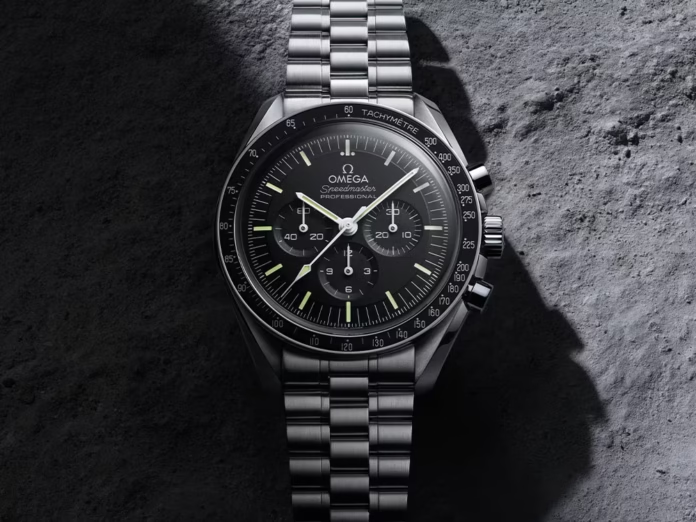Few timepieces in history command the respect and admiration of the Omega Speedmaster Professional. Known to millions as the “Moonwatch,” its legendary status was cemented when it became the first and only watch worn on the lunar surface during the Apollo 11 mission. Yet, to believe its relevance begins and ends with that single, extraordinary event is to overlook a rich history of purpose-driven design, a legacy of technical innovation, and an enduring emotional resonance that makes it one of the most significant chronographs ever made.
A history born of the track, raised in the stars
The Speedmaster’s journey to the moon began not with astronauts, but with racing drivers. Introduced in 1957, the first Speedmaster (Reference CK2915) was a robust sports chronograph designed for motorsport enthusiasts. It featured a high-contrast black dial with luminous hands for legibility and, critically, was the first wristwatch to place its tachymeter scale on the bezel. This functional design choice allowed drivers to easily measure speed and elapsed time, and it laid the foundation for the watch’s enduring aesthetic.
In 1964, NASA, searching for a robust and reliable timepiece for its astronauts, discreetly purchased chronographs from several brands for testing. The watches were subjected to a barrage of extreme conditions, including shocks, vibrations, and massive temperature fluctuations. Only the Omega Speedmaster survived the tests intact and was officially certified as “Flight Qualified for all Manned Space Missions”.
The true legend was forged on July 20, 1969, during the Apollo 11 mission. As Neil Armstrong and Buzz Aldrin stepped onto the lunar surface, Aldrin wore his Speedmaster Professional, forever tying the watch to one of humanity’s greatest achievements. The watch’s reputation for reliability was further solidified during the Apollo 13 mission in 1970, when astronauts famously used their Speedmasters to time a critical 14-second engine burn, enabling their safe return to Earth. For this heroic act, Omega was awarded NASA’s prestigious Silver Snoopy Award.
A blend of heritage and modern technology
While its historic manual-wind movements, like the Calibre 321 and later Calibre 861/1861, are revered by collectors, the modern Speedmaster Professional continues to evolve. Today’s standard Moonwatch is powered by the OMEGA Co-Axial Master Chronometer Calibre 3861. This movement represents a significant technical leap, combining the traditional hand-wound ritual with modern advancements.
Key specifications of the latest reference (e.g., ref. 310.30.42.50.01.001 with hesalite crystal):
- Case: 42mm asymmetrical stainless steel case. Its unique “twisted lug” design has been a hallmark of the Professional series since 1964.
- Movement: Manual-winding Calibre 3861. It features a Co-Axial escapement, anti-magnetic resistance up to 15,000 gauss, and a 50-hour power reserve. It is also Master Chronometer certified by METAS, guaranteeing exceptional precision.
- Dial: The classic stepped, black dial with three recessed subdials remains virtually unchanged from the historic lunar model.
- Crystal: Purists can still choose the more historically accurate hesalite (acrylic) crystal, which is shatter-resistant, or opt for a modern, scratch-resistant sapphire crystal.
- Bezel: The black anodized aluminum tachymeter bezel, featuring the historically accurate “dot over 90” and “dot diagonal to 70,” is a favorite detail among enthusiasts.
Pricing and market position
The Omega Speedmaster Professional remains a surprisingly accessible “icon” watch, particularly when compared to other chronographs with similar status. New, steel Moonwatch models currently retail for between approximately $7,400 and $9,000, depending on the crystal and strap choice. This accessibility, along with the option to purchase pre-owned models for less, makes it a popular entry point for many collectors.
However, prices can vary dramatically for special editions and vintage models. Commemorative editions, like the popular Silver Snoopy Award models, have limited production runs and can command prices well above retail on the secondary market. Similarly, highly sought-after vintage examples, such as those with the original Calibre 321, can fetch significant sums at auction.
Why the Speedmaster Professional still matters
The Omega Speedmaster Professional’s enduring appeal extends far beyond its price and technical specifications. It is a watch that embodies a rare and potent combination of storytelling, design, and function.
- Emotional connection: Owning a Speedmaster is owning a tangible piece of history. It connects wearers to the romance of space exploration, the courage of the astronauts, and the sheer audacity of landing on the moon.
- Timeless design: The watch’s design is a triumph of function and form. It has remained largely unchanged for decades, proving its aesthetic was never a passing trend. It is versatile, equally at home on a leather strap with a suit or on a NATO strap with a t-shirt.
- Authentic tool watch: Unlike some luxury watches that have evolved into pure status symbols, the Speedmaster remains a true tool watch at its core. Its proven resilience in the most extreme conditions imaginable gives it a legitimacy that few rivals can match.
- The alternative to scarcity: While the Rolex Daytona remains notoriously difficult to acquire, the Speedmaster offers a legendary chronograph with an even richer history that collectors can realistically purchase.
The Omega Speedmaster Professional is more than just a watch; it’s a testament to human ingenuity and a reminder of a time when the boundaries of possibility were pushed beyond Earth itself. In an era of fleeting trends and digital distractions, its classic design, bulletproof mechanics, and extraordinary story ensure its status as a timeless icon.
